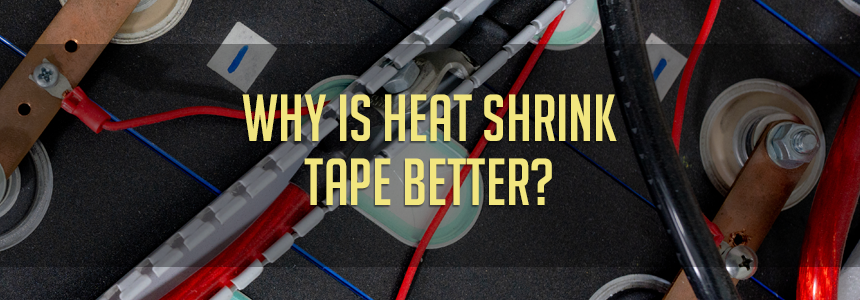Why is Heat Shrink Tape Better?

If you’ve ever found yourself in an electrical pinch - a situation where you need to fix your wiring or cables fast, you may have reached for duct tape or standard electrical tape. It’s a quick and fairly easy solution. If you’re like most people, you probably always have a roll of duct tape or electrical tape in your home or office. After the fix, you might tell yourself it's time to buy new wires, or tell yourself that you’ll go back when you have time and properly repair your wiring.
The truth is you can save yourself this time and energy (and a potential electrical hazard), by keeping heat shrink tape in your home or office for more permanent solutions to your wiring issues. Duct tape or any adhesive tape will not do the job safely or securely. Prolong the life of your cables and wires with a permanent fix like heat shrink tape.
What is Heat Shrink Tape?
Most commonly, heat shrink tape is heat melted adhesive lined polyolefin tape. It features dual-wall properties, an internal wall of hot-melt adhesive which provides excellent bonding to plastic and metal. It forms pressure-tight and waterproof seals to communications, power cables and most electrical wires and cables. It is also a more convenient choice than heat shrink tubing, especially if you’re unable to disconnect the wiring or cabling to slide on the tubing.
Adhesive lined heat shrinkable tape works exactly like normal electrical tape, simply by wrapping it around your wire and then using a heat gun to activate the cross-linking capabilities, you've got a water-tight seal without hours of labor reattaching your connector. At BuyHeatShrink, the ideal heat shrink temperature for our heat shrink tape is around 221°F (105°C).
So why does heat shrink tape perform better in electrical situations than duct tape or regular electrical tape?
Duct Tape
For starters, a common feature of every office or household is good, old, reliable duct tape. For good reason too, duct tape holds a lot of benefits:
- Durability
- Adhesive and general strength
- Water resistant (not waterproof)
- Can be used on all types of surfaces
Duct tape is a multi-purpose utility product that can be used for many day-to-day needs. It has the capability of holding up things for relatively long periods of time, unlike electrical tapes. It’s also far more durable and strong when compared with electrical tape. It’s water resistant properties also make it better at holding moisture in or out.
When it comes to electrical power like wiring or cables, duct tape is not a suitable substitute for electrical or heat shrink tape. Unlike heat shrink tape or standard electrical tape, duct tape does not offer the same fire-resistant and conductive properties. It is also generally more expensive than electrical tape.
Electrical and heat shrink tape is specifically designed and produced for meeting the day-to-day needs of electricians and is a much more appropriate choice when adhesive tape is required in an electrical context.
Electrical Tape
Electrical tape is an obvious improvement from duct tape when it comes to your wiring needs. It is a pressure-sensitive tape used to insulate materials that conduct electricity, specifically electrical wires. It stops the electrical current from accidentally passing to other wires, which could create a short circuit or even start a fire.
According to TapeUniversity, electrical tapes are typically made with a polyvinylchloride (PVC) backing and a non-corrosive rubber-based adhesive. Like heat shrink tape, the backing is what gives it the ability to stretch and stick to cables and wiring. This stretch is a critical characteristic of these tapes because it allows the tape to wrap tightly around cables for long-lasting insulation. Most cloth, film, and other types of tapes do not possess the same characteristics.
Charged electrical wiring can also cause materials used in certain types of tape to dry out and even catch fire. For example, the cloth fibers used in the backings of many duct tapes are susceptible to burning at high voltages, creating a fire risk. You wouldn’t want to use a duct tape or other cloth tape to insulate wiring.
Electrical tape and heat shrink tape share a lot of similar properties and goals for their usability. Like heat shrink tape, most electrical tapes have been rigorously tested to ensure they withstand environmental elements, such as cold temperature, moisture, and sunlight.
Electrical tapes are built for use in specific tasks that other tapes cannot stand up to. Cable insulation, phasing, and splicing jobs depend on good quality electrical tapes to get the job done right.
Why heat shrink tape is better than electrical tape
Like electrical tape, heat shrink tape comes in a wide variety of colors. Some individuals choose colored tape so it's easier to identify where repairs were required. However, electricians and contractors know the various colors actually indicate and are used to differentiate wire voltage or phases of the wire.
It is essential to monitor the status of your electrical tape, as for all its ease-of-use, electrical tape is also easy to remove, whether it is intentional or happens naturally on its own.
The clear advantage of electrical tape is that it helps provide a near-instant fix to many electrical issues—but this is also its main downside. Too often, electrical tape is applied in an impermanent fashion and expected to last forever. With the proper heat shrink on hand, a safer and longer-lasting solution is only steps away.
Want to know more about Heat Shrink?
Hopefully, this guide has helped you understand all you need to know to choose the best type of tape for your wiring application. Set up an account or log in to put in an order.
If you have additional questions, visit our learning center or FAQs. Or you can contact us here with questions or to receive a sample.














